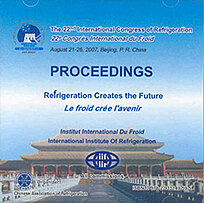
Résumé
Climate change, air pollution, ozone depletion and other environmental issues are worldwide hot points which makes make development become a focus. Green building is a sustainable label in building industry and since 1990s, the developed countries have developed respective building environmental assessment system based on their own background. Firstly, this paper introduces two main methods for building environmental assessment system, and they are checklist and life cycle assessment. After analyzing the existing environmental assessment system, this paper summarizes the main shortages and puts forward a new assessment methodology-exergy assessment. Exergy is a thermodynamic term and widely used in energy field. It can be used to measure resource quantity and quality. Thus, exergy is introduced to measure building environmental impacts by separating the environmental impacts into three parts: energy-related resource, non-energy-related resource and environmental pollution. The paper gives a brief presentation on the measurement of the three parts' environmental impacts. Finally, the paper develops a building environmental assessment system based on exergy and life cycle analysis.
Documents disponibles
Format PDF
Pages : ICR07-E1-1551
Disponible
Prix public
20 €
Prix membre*
Gratuit
* meilleur tarif applicable selon le type d'adhésion (voir le détail des avantages des adhésions individuelles et collectives)
Détails
- Titre original : Exergy assessment for building environmental impacts.
- Identifiant de la fiche : 2008-0301
- Langues : Anglais
- Sujet : Environnement, Généralités
- Source : ICR 2007. Refrigeration Creates the Future. Proceedings of the 22nd IIR International Congress of Refrigeration.
- Date d'édition : 21/08/2007
Liens
Voir d'autres communications du même compte rendu (839)
Voir le compte rendu de la conférence
-
Impact of climate change on buildings.
- Auteurs : CRAWLEY D. B.
- Date : 24/09/2003
- Langues : Anglais
Voir la fiche
-
A rational exergy management model for sustaina...
- Auteurs : KILKIS S.
- Date : 02/12/2009
- Langues : Anglais
- Source : Zbornik radova. 40. Medunarodni kongres o grejanju, hladenju i klimatizaciji./ Proceedings. 40th International congress on HVAC&R.
- Formats : PDF
Voir la fiche
-
Application of global temperature potential to ...
- Auteurs : COLBOURNE D., SUEN K. O.
- Date : 01/08/2004
- Langues : Anglais
- Source : Natural Working Fluids 2004: 6th IIR-Gustav Lorentzen Conference
- Formats : PDF
Voir la fiche
-
A whole building life-cycle assessment approach...
- Auteurs : ZHANG H., CAI J., BRAUN J. E.
- Date : 24/05/2021
- Langues : Anglais
- Source : 2021 Purdue Conferences. 6th International High Performance Buildings Conference at Purdue.
- Formats : PDF
Voir la fiche
-
Effect of local CO2 release of refrigeration an...
- Auteurs : VÁRSZEGI T., CZÓBEL S., SZIRMAI O.
- Date : 21/08/2007
- Langues : Anglais
- Source : ICR 2007. Refrigeration Creates the Future. Proceedings of the 22nd IIR International Congress of Refrigeration.
- Formats : PDF
Voir la fiche
